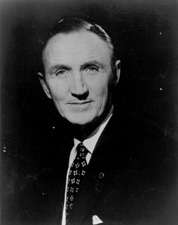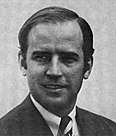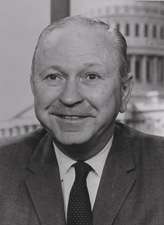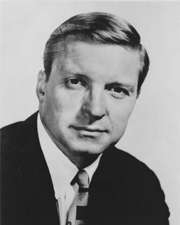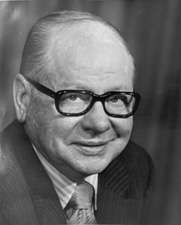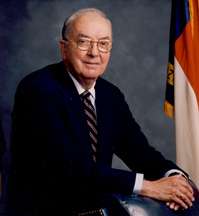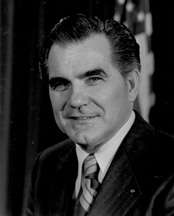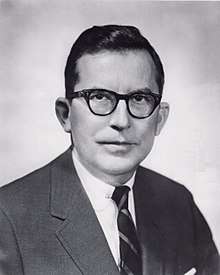United States Senate elections, 1972
|
| |||||||||||||||||||||||||||||||||||||||||||||||||||||||||||||||||
| |||||||||||||||||||||||||||||||||||||||||||||||||||||||||||||||||
34 of the 100 seats in the United States Senate 51 seats needed for a majority | |||||||||||||||||||||||||||||||||||||||||||||||||||||||||||||||||
|---|---|---|---|---|---|---|---|---|---|---|---|---|---|---|---|---|---|---|---|---|---|---|---|---|---|---|---|---|---|---|---|---|---|---|---|---|---|---|---|---|---|---|---|---|---|---|---|---|---|---|---|---|---|---|---|---|---|---|---|---|---|---|---|---|---|
| |||||||||||||||||||||||||||||||||||||||||||||||||||||||||||||||||
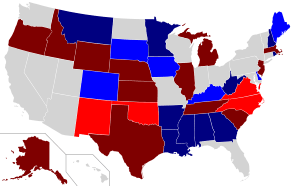 Results, with special elections Democratic gain Democratic hold Republican gain Republican hold | |||||||||||||||||||||||||||||||||||||||||||||||||||||||||||||||||
| |||||||||||||||||||||||||||||||||||||||||||||||||||||||||||||||||
The 1972 United States Senate elections coincided with the landslide re-election of Republican President Richard Nixon. Despite Nixon's victory, Democrats increased their majority by two seats. After the elections, Democrats held 56 seats and Republicans held 42 seats, with 1 Conservative and 1 independent Senator. These were the first elections in which all citizens at least 18 years of age (instead of 21 and older) could vote due to the 1971 passage of the 26th Amendment.
Results summary
| Parties | Total seats | Popular vote | ||||||||||
|---|---|---|---|---|---|---|---|---|---|---|---|---|
| Incum- bents |
Not up |
This election | Result | +/- | Vote | % | ||||||
| Up | Re- elected |
Held | Gained | Lost | ||||||||
| Democratic | 54 | 40 | 14 | 8 | 2 | 56 | 17,199,567 | 45.49% | ||||
| Republican | 44 | 24 | 20 | 13 | 1 | 42 | 19,821,203 | 52.42% | ||||
| Independent | 1 | 1 | 0 | 0 | 0 | 1 | 318,238 | 0.84% | ||||
| Conservative (N.Y.) | 1 | 1 | 0 | 0 | 0 | 1 | 42,348 | 0.11% | ||||
| Others | 0 | 0 | 0 | 0 | 0 | 0 | 470,090 | 1.24% | ||||
| Total | 100 | 66 | 34 | 21 | 3 | 100 | 37,809,098 | 100.0% | ||||
Source: Clerk of the U.S. House of Representatives (1973). "Statistics of the Presidential and Congressional Election of November 7, 1972" (PDF). U.S. Government Printing Office.
Gains and losses
Democratic pickups included open seats in Kentucky and South Dakota, and defeats of Senators Gordon L. Allott of Colorado, J. Caleb Boggs of Delaware, Jack Miller of Iowa, and Margaret Chase Smith of Maine.
Republican pickups included open seats in New Mexico, North Carolina, and Oklahoma, and the defeat of incumbent William B. Spong, Jr. of Virginia.
Change in Senate composition
Before the elections
After the January 7, 1972 Vermont special election.
| D1 | D2 | D3 | D4 | D5 | D6 | D7 | D8 | D9 | D10 |
| D20 | D19 | D18 | D17 | D16 | D15 | D14 | D13 | D12 | D11 |
| D21 | D22 | D23 | D24 | D25 | D26 | D27 | D28 | D29 | D30 |
| D40 | D39 | D38 | D37 | D36 | D35 | D34 | D33 | D32 | D31 |
| D41 Ran |
D42 Ran |
D43 Ran |
D44 Ran |
D45 Ran |
D46 Ran |
D47 Ran |
D48 Ran |
D49 Ran |
D50 Ran |
| Majority → | D51 Ran | ||||||||
| R41 Ran |
R42 Retired |
R43 Retired |
R44 Retired |
C1 | I1 | D54 Retired |
D53 Retired |
D52 Retired | |
| R40 Ran |
R39 Ran |
R38 Ran |
R37 Ran |
R36 Ran |
R35 Ran |
R34 Ran |
R33 Ran |
R32 Ran |
R31 Ran |
| R21 | R22 | R23 | R24 | R25 | R26 Ran |
R27 Ran |
R28 Ran |
R29 Ran |
R30 Ran |
| R20 | R19 | R18 | R17 | R16 | R15 | R14 | R13 | R12 | R11 |
| R1 | R2 | R3 | R4 | R5 | R6 | R7 | R8 | R9 | R10 |
After the general elections
| D1 | D2 | D3 | D4 | D5 | D6 | D7 | D8 | D9 | D10 |
| D20 | D19 | D18 | D17 | D16 | D15 | D14 | D13 | D12 | D11 |
| D21 | D22 | D23 | D24 | D25 | D26 | D27 | D28 | D29 | D30 |
| D40 | D39 | D38 | D37 | D36 | D35 | D34 | D33 | D32 | D31 |
| D41 Re-elected |
D42 Re-elected |
D43 Re-elected |
D44 Re-elected |
D45 Re-elected |
D46 Re-elected |
D47 Re-elected |
D48 Re-elected |
D49 Hold |
D50 Hold |
| Majority → | D51 Gain | ||||||||
| R41 Gain |
R42 Gain |
C1 | I1 | D56 Gain |
D55 Gain |
D54 Gain |
D53 Gain |
D52 Gain | |
| R40 Gain |
R39 Gain |
R38 Hold |
R37 Re-elected |
R36 Re-elected |
R35 Re-elected |
R34 Re-elected |
R33 Re-elected |
R32 Re-elected |
R31 Re-elected |
| R21 | R22 | R23 | R24 | R25 | R26 Re-elected |
R27 Re-elected |
R28 Re-elected |
R29 Re-elected |
R30 Re-elected |
| R20 | R19 | R18 | R17 | R16 | R15 | R14 | R13 | R12 | R11 |
| R1 | R2 | R3 | R4 | R5 | R6 | R7 | R8 | R9 | R10 |
After the November special elections
| D1 | D2 | D3 | D4 | D5 | D6 | D7 | D8 | D9 | D10 |
| D20 | D19 | D18 | D17 | D16 | D15 | D14 | D13 | D12 | D11 |
| D21 | D22 | D23 | D24 | D25 | D26 | D27 | D28 | D29 | D30 |
| D40 | D39 | D38 | D37 | D36 | D35 | D34 | D33 | D32 | D31 |
| D41 | D42 | D43 | D44 | D45 | D46 | D47 | D48 | D49 | D50 |
| Majority → | D51 | ||||||||
| R41 | R42 | C1 | I1 | D56 Hold |
D55 | D54 | D53 | D52 | |
| R40 | R39 | R38 | R37 | R36 | R35 | R34 | R33 | R32 | R31 |
| R21 | R22 | R23 | R24 | R25 | R26 | R27 | R28 | R29 | R30 |
| R20 | R19 | R18 | R17 | R16 | R15 | R14 | R13 | R12 | R11 |
| R1 | R2 | R3 | R4 | R5 | R6 | R7 | R8 | R9 | R10 |
| Key: |
|
|---|
Race summaries
Special elections during the 92nd Congress
In these special elections, the winner was seated during 1972 or before January 3, 1973; ordered by election date, then state.
| State (linked to summaries below) |
Incumbent | Results | Candidates | ||
|---|---|---|---|---|---|
| Senator | Party | Electoral history | |||
| Vermont (Class 1) |
Robert Stafford | Republican | 1971 (Appointed) | Interim appointee elected. | √ Robert Stafford (Republican) 64.4% Randolph T. Major (Democratic) 33.4% Bernie Sanders (Liberty Union) 2.2%[2] |
| Georgia (Class 2) |
David H. Gambrell | Democratic | 1971 (Appointed) | Interim appointee lost nomination. New senator elected November 7, 1972. Democratic hold. Winner also elected to the next term, see below. |
√ Sam Nunn (Democratic) 52.0% S. Fletcher Thompson (Republican) 46.5% Alice Conner (Independent) 1.0% George Schmidt (Independent) 0.5%[3] |
Elections leading to the next Congress
In these general elections, the winners were elected for the term beginning January 3, 1973; ordered by state.
All of the elections involved the Class 2 seats.
| State (linked to summaries below) |
Incumbent | Results | Candidates | ||
|---|---|---|---|---|---|
| Senator | Party | Electoral history | |||
| Alabama | John Sparkman | Democratic | 1946 (Special) 1948 1954 1960 1966 |
Incumbent re-elected. | √ John Sparkman (Democratic) 62.3% Winton M. Blount (Republican) 33.1% John L. LeFlore (Nat'l Democratic) 3.0% Jerome Couch (AL Prohibition) 1.0% Herbert Stone (AL Conservative) 0.6% |
| Alaska | Ted Stevens | Republican | 1968 (Appointed) 1970 (Special) |
Incumbent re-elected. | √ Ted Stevens (Republican) 77.3% Gene Guess (Democratic) 22.7% |
| Arkansas | John McClellan | Democratic | 1942 1948 1954 1960 1966 |
Incumbent re-elected. | √ John McClellan (Democratic) 60.8% Wayne H. Babbitt (Republican) 39.1% |
| Colorado | Gordon L. Allott | Republican | 1954 1960 1966 |
Incumbent lost re-election. New senator elected. Democratic gain. |
√ Floyd K. Haskell (Democratic) 49.4% Gordon L. Allott (Republican) 48.4% Secundion Salazar (Raza Unida) 1.4% Henry Olshaw (American) 0.8% |
| Delaware | J. Caleb Boggs | Republican | 1960 1966 |
Incumbent lost re-election. New senator elected. Democratic gain. |
√ Joe Biden (Democratic) 50.5% J. Caleb Boggs (Republican) 49.1% |
| Georgia | David H. Gambrell | Democratic | 1971 (Appointed) | Incumbent lost nomination. New senator elected. Democratic hold. Winner also elected to finish the term, see above. |
√ Sam Nunn (Democratic) 54.0% Fletcher Thompson (Republican) 46.0%[3] |
| Idaho | Leonard B. Jordan | Republican | 1962 (Appointed) 1962 (Special) 1966 |
Incumbent retired. New senator elected. Republican hold. |
√ James A. McClure (Republican) 52.3% William E. Davis (Democratic) 45.5% |
| Illinois | Charles H. Percy | Republican | 1966 | Incumbent re-elected. | √ Charles H. Percy (Republican) 62.2% Roman Pucinski (Democratic) 37.4% |
| Iowa | Jack Miller | Republican | 1960 1966 |
Incumbent lost re-election. New senator elected. Democratic gain. |
√ Dick Clark (Democratic) 55.1% Jack Miller (Republican) 44.1% |
| Kansas | James B. Pearson | Republican | 1962 (Appointed) 1962 (Special) 1966 |
Incumbent re-elected. | √ James B. Pearson (Republican) 71.4% Arch Tetzlaff (Democratic) 23.0% |
| Kentucky | John Sherman Cooper | Republican | 1946 (Special) 1948 (Lost) 1952 (Special) 1954 (Lost) 1956 (Special) 1960 1966 |
Incumbent retired. New senator elected. Democratic gain. |
√ Walter D. Huddleston (Democratic) 50.9% Louie B. Nunn (Republican) 47.6% |
| Louisiana | Elaine Edwards | Democratic | 1972 (Appointed) | Interim appointee retired. New senator elected. Democratic hold. Interim appointee resigned November 13, 1972 to give successor preferential seniority. Winner appointed November 14, 1972. |
√ Bennett Johnston (Democratic) 55.2% John McKeithen (Independent) 23.1% Ben Toledano (Republican) 16.1% Hall M. Lyons (American Party), 2.7% |
| Maine | Margaret Chase Smith | Republican | 1948 1954 1960 1966 |
Incumbent lost re-election. New senator elected. Democratic gain. |
√ William Hathaway (Democratic) 53.2% Margaret Chase Smith (Republican) 46.8% |
| Massachusetts | Edward Brooke | Republican | 1966 | Incumbent re-elected. | √ Edward Brooke (Republican) 63.5% John J. Droney (Democratic) 34.7% Donald Gurewitz (Socialist Workers) 1.7% |
| Michigan | Robert P. Griffin | Republican | 1966 (Appointed) 1966 |
Incumbent re-elected. | √ Robert P. Griffin (Republican) 52.3% Frank J. Kelley (Democratic) 46.3% |
| Minnesota | Walter Mondale | Democratic | 1964 (Appointed) 1966 |
Incumbent re-elected. | √ Walter Mondale (Democratic) 56.7% Phil Hansen (Republican) 42.9% |
| Mississippi | James Eastland | Democratic | 1942 1948 1954 1960 1966 |
Incumbent re-elected. | √ James Eastland (Democratic) 58.1% Gil Carmichael (Republican) 38.7% |
| Montana | Lee Metcalf | Democratic | 1960 1966 |
Incumbent re-elected. | √ Lee Metcalf (Democratic) 52.0% Henry S. Hibbard (Republican) 48.1% |
| Nebraska | Carl Curtis | Republican | 1954 1960 1966 |
Incumbent re-elected. | √ Carl Curtis (Republican) 53.1% Terry Carpenter (Democratic) 46.8% |
| New Hampshire | Thomas J. McIntyre | Democratic | 1962 (Special) 1966 |
Incumbent re-elected. | √ Thomas J. McIntyre (Democratic) 56.9% Wesley Powell (Republican) 43.1% |
| New Jersey | Clifford P. Case | Republican | 1954 1960 1966 |
Incumbent re-elected. | √ Clifford P. Case (Republican) 62.5% Paul J. Krebs (Democratic) 34.5% |
| New Mexico | Clinton P. Anderson | Democratic | 1948 1954 1960 1966 |
Incumbent retired. New senator elected. Republican gain. |
√ Pete Domenici (Republican) 54.0% Jack Daniels (Democratic) 46.0% |
| North Carolina | B. Everett Jordan | Democratic | 1958 (Appointed) 1958 (Special) 1960 1966 |
Incumbent lost renomination. New senator elected. Republican gain. |
√ Jesse Helms (Republican) 54.0% Nick Galifianakis (Democratic) 46.0% |
| Oklahoma | Fred R. Harris | Democratic | 1964 (Special) 1966 |
Incumbent retired. New senator elected. Republican gain. |
√ Dewey F. Bartlett (Republican) 51.4% Ed Edmondson (Democratic) 47.6% |
| Oregon | Mark Hatfield | Republican | 1966 | Incumbent re-elected. | √ Mark Hatfield (Republican) 53.7% Wayne Morse (Democratic) 46.2% |
| Rhode Island | Claiborne Pell | Democratic | 1960 1966 |
Incumbent re-elected. | √ Claiborne Pell (Democratic) 53.7% John Chafee (Republican) 45.7% |
| South Carolina | Strom Thurmond | Republican | 1954 1954 (Appointed) 1956 (Resigned) 1956 (Special) 1960 1966 |
Incumbent re-elected. | √ Strom Thurmond (Republican) 63.3% Eugene N. Zeigler (Democratic) 36.7% |
| South Dakota | Karl Earl Mundt | Republican | 1948 1948 (Appointed) 1954 1960 1966 |
Incumbent retired. New senator elected. Democratic gain. |
√ James Abourezk (Democratic) 57.0% Robert W. Hirsch (Republican) 42.9% |
| Tennessee | Howard Baker | Republican | 1966 | Incumbent re-elected. | √ Howard Baker (Republican) 61.6% Ray Blanton (Democratic) 37.9% |
| Texas | John Tower | Republican | 1961 (Special) 1966 |
Incumbent re-elected. | √ John Tower (Republican) 53.4% Barefoot Sanders (Democratic) 44.3% |
| Virginia | William B. Spong, Jr. | Democratic | 1966 | Incumbent lost re-election. New senator elected. Republican gain. |
√ William L. Scott (Republican) 51.5% William B. Spong, Jr. (Democratic) 46.1% |
| West Virginia | Jennings Randolph | Democratic | 1958 (Special) 1960 1966 |
Incumbent re-elected. | √ Jennings Randolph (Democratic) 66.5% Louise Leonard (Republican) 33.6% |
| Wyoming | Clifford Hansen | Republican | 1966 | Incumbent re-elected. | √ Clifford Hansen (Republican) 71.3% Mike Vinich (Democratic) 28.7% |
Alabama
Alaska
Arkansas
Colorado
Delaware
|
| |||||||||||||||||
| |||||||||||||||||
 County results | |||||||||||||||||
| |||||||||||||||||
Incumbent Republican J. Caleb Boggs ran for a third term. Boggs faced off against Joe Biden, a New Castle County Councilman. Though Senator Boggs was expected to easily win a third term over the then-unknown Biden, it ended up being the closest Senate election in 1972, and Biden narrowly beat out Boggs by a little over three thousand votes, winning what would be his first of seven terms.
Longtime Delaware political figure and Republican incumbent Senator J. Caleb Boggs was considering retirement, which would likely have left U.S. Representative Pete du Pont and Wilmington Mayor Harry G. Haskell, Jr. in a divisive primary fight. To avoid that, U.S. President Richard M. Nixon helped convince Boggs to run again with full party support.[4]
No other Democrat wanted to run against Boggs besides Biden, a New Castle County Councilman.[5] Biden's campaign had virtually no money and was given no chance of winning.[6] It was managed by his sister Valerie Biden Owens (who would go on to manage his future campaigns as well) and staffed by other members of his family, and relied upon handed-out newsprint position papers.[7] Biden did receive some assistance from the AFL-CIO and Democratic pollster Patrick Caddell.[5] Biden's campaign issues focused on withdrawal from Vietnam, the environment, civil rights, mass transit, more equitable taxation, health care, the public's dissatisfaction with politics-as-usual, and "change".[5][7]
During the summer Biden trailed by almost 30 percentage points,[5] but his energy level, his attractive young family, and his ability to connect with voters' emotions gave the surging Biden an advantage over the ready-to-retire Boggs.[8] Biden won the November 7, 1972 election in an upset by a margin of 3,162 votes.[7]
At the time of the election Biden was a little less than 30 years old; age 30 is a constitutional requirement for the U.S. Senate, and he reached that on November 20, in time for the Senate term beginning January 3. After his election he became the sixth-youngest Senator in history.[9]
| Party | Candidate | Votes | % | ± | |
|---|---|---|---|---|---|
| Democratic | Joe Biden | 116,006 | 50.48% | +9.59% | |
| Republican | J. Caleb Boggs (Incumbent) | 112,844 | 49.10% | -10.02% | |
| American | Henry Majka | 803 | 0.35% | ||
| Prohibition | Herbert B. Wood | 175 | 0.07% | ||
| Majority | 3,162 | 1.38% | -16.86% | ||
| Turnout | 229,828 | ||||
| Democratic gain from Republican | Swing | ||||
Georgia
Georgia (Special)
Idaho
Illinois
|
| |||||||||||||||||
| |||||||||||||||||
| |||||||||||||||||
Incumbent Republican Charles H. Percy sought re-election. Percy was opposed by: Democratic nominee Roman Pucinski, a Congressman from Illinois's 11th congressional district, Edward C. Gross (SL) and Arnold Becchetti (C). Percy handily won a second term.
| Party | Candidate | Votes | % | ± | |
|---|---|---|---|---|---|
| Republican | Charles H. Percy, (Incumbent) | 2,867,078 | 61.21% | +7.27% | |
| Democratic | Roman Pucinski | 1,721,031 | 37.35% | -6.55% | |
| Socialist Labor | Edward C. Gross | 13,384 | 0.29% | ||
| Communist | Arnold Becchetti | 6,103 | 0.13% | ||
| Write-ins | 784 | 0.02% | |||
| Majority | 1,146,047 | 24.87% | +13.82% | ||
| Turnout | 3,822,724 | ||||
| Republican hold | Swing | ||||
Iowa
Kansas
Kentucky
Louisiana
Maine
|
| |||||||||||||||||
| |||||||||||||||||
| |||||||||||||||||
Incumbent Republican Margaret Chase Smith ran for re-election to a fifth term, but was defeated by Democrat William Hathaway, member of the U.S. House of Representatives from Maine's 2nd congressional district.
| Party | Candidate | Votes | % | |
|---|---|---|---|---|
| Democratic | William Hathaway | 224,270 | 53.23% | |
| Republican | Margaret Chase Smith (Incumbent) | 197,040 | 46.77% | |
Massachusetts
|
| |||||||||||||||||
| |||||||||||||||||
 Results by town. Red indicates towns carried by Edward Brooke, blue indicates towns carried by John J. Droney. | |||||||||||||||||
| |||||||||||||||||
Incumbent Republican Edward Brooke, first elected in 1966 as the first African-American elected to the Senate by popular vote.[12], defeated his challengers, among them: John J. Droney, the Middlesex County District Attorney.[13]
| Party | Candidate | Votes | % | ± | |
|---|---|---|---|---|---|
| Democratic | John J. Droney | 215,523 | 45.05% | ||
| Democratic | Gerald O'Leary | 169,876 | 35.51% | ||
| Democratic | John P. Lynch | 92,979 | 19.43% | ||
| Party | Candidate | Votes | % | ± | |
|---|---|---|---|---|---|
| Republican | Edward Brooke | 1,505,932 | 63.53% | +2.85% | |
| Democratic | John J. Droney | 823,278 | 34.73% | -4.01% | |
| Socialist Workers | Donald Gurewitz | 41,369 | 1.75% | +1.41% | |
Michigan
Minnesota
|
| |||||||||||||||||
| |||||||||||||||||
| |||||||||||||||||
Incumbent Democrat Walter Mondale, who was originally appointed in 1964 (to fill the vacancy create when Hubert Humphrey was elected to the office of Vice President) and elected to a full term in 1966, defeated Republican challenger Phil Hansen.
| Party | Candidate | Votes | % | |
|---|---|---|---|---|
| DFL | Walter F. Mondale (Incumbent) | 230,679 | 89.88% | |
| DFL | Tom Griffin | 11,266 | 4.39% | |
| DFL | Richard "Dick" Leaf | 7,750 | 3.02% | |
| DFL | Ralph E. Franklin | 6,946 | 2.71% | |
| Party | Candidate | Votes | % | |
|---|---|---|---|---|
| Republican | Phil Hansen | 165,093 | 100.00% | |
| Party | Candidate | Votes | % | |
|---|---|---|---|---|
| DFL | Walter F. Mondale (Incumbent) | 981,320 | 56.67% | |
| Republican | Phil Hansen | 742,121 | 42.86% | |
| Industrial Government | Karl H. Heck | 8,192 | 0.47% | |
Mississippi
|
| |||||||||||||||||
| |||||||||||||||||
| |||||||||||||||||
| Party | Candidate | Votes | % | |
|---|---|---|---|---|
| Democratic | James Eastland | 375,102 | 58.09% | |
| Republican | Gil Carmichael | 249,779 | 38.68% | |
| Independent | Prentiss Walker | 14,662 | 2.27% | |
| Independent | C.L.McKinley | 6,203 | 0.96% | |
Montana
|
| |||||||||||||||||
| |||||||||||||||||
| |||||||||||||||||
Incumbent Democrat Lee Metcalf, who was first elected to the Senate in 1960 and was re-elected in 1966, ran for re-election. After winning the Democratic primary, he moved on to the general election, where he faced Hank Hibbard, a State Senator and the Republican nominee. Following a close campaign, Metcalf managed to narrowly win re-election to his third term in the Senate over Hibbard.
| Party | Candidate | Votes | % | |
|---|---|---|---|---|
| Democratic | Lee Metcalf (Incumbent) | 106,491 | 86.42% | |
| Democratic | Jerome Peters | 16,729 | 13.58% | |
| Total votes | 123,220 | 100.00% | ||
| Party | Candidate | Votes | % | |
|---|---|---|---|---|
| Republican | Hank Hibbard, State Senator | 43,028 | 49.70% | |
| Republican | Harold E. Wallace, 1970 GOP Senate nominee | 26,463 | 30.57% | |
| Republican | Norman C. Wheeler | 13,826 | 15.97% | |
| Republican | Merrill K. Riddick | 3,259 | 3.76% | |
| Total votes | 86,576 | 100.00% | ||
| Party | Candidate | Votes | % | ± | |
|---|---|---|---|---|---|
| Democratic | Lee Metcalf (Incumbent) | 163,609 | 51.95% | -1.22% | |
| Republican | Hank Hibbard | 151,316 | 48.05% | +1.22% | |
| Majority | 12,293 | 3.90% | -2.43% | ||
| Turnout | 314,925 | ||||
| Democratic hold | Swing | ||||
Nebraska
|
| |||||||||||||||||
| |||||||||||||||||
| |||||||||||||||||
Incumbent Republican Carl Curtis won re-election.
| Party | Candidate | Votes | % | ± | |
|---|---|---|---|---|---|
| Republican | Carl Curtis (Incumbent) | 301,841 | 53.16% | -7.88% | |
| Democratic | Terry Carpenter, former congressman | 265,922 | 46.84% | +8.09% | |
| Majority | 35,919 | 6.33% | -15.97% | ||
| Turnout | 567,763 | ||||
| Republican hold | Swing | ||||
New Hampshire
New Jersey
New Mexico
North Carolina
|
| |||||||||||||||||
| |||||||||||||||||
| |||||||||||||||||
Oklahoma
Oregon
Rhode Island
South Carolina
South Carolina (Special)
South Dakota
Tennessee
Texas
Vermont (Special)
|
| |||||||||||||||||
| |||||||||||||||||
| |||||||||||||||||
| |||||||||||||||||
The special election was held January 7, 1972. Incumbent Republican Robert Stafford, appointed in September 1971 to fill the vacancy created by the death of Winston L. Prouty, successfully ran for re-election to the remainder of Prouty's term in the United States Senate. Stafford defeated Democratic candidate Randolph T. Major. Bernie Sanders, the Liberty Union candidate,[20] was later elected to this seat in 2006, serving as an Independent.
| Party | Candidate | Votes | % | ± | |
|---|---|---|---|---|---|
| Republican | Robert Stafford (Incumbent) | 45,888 | 64.4 | ||
| Democratic | Randolph T. Major | 23,842 | 33.4 | ||
| Liberty Union | Bernie Sanders | 1,571 | 2.2 | ||
| Total votes | 71,301 | 100 | |||
Virginia
|
| |||||||||||||||||
| Turnout | 44.7%[21] | ||||||||||||||||
|---|---|---|---|---|---|---|---|---|---|---|---|---|---|---|---|---|---|
| |||||||||||||||||
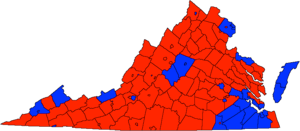 U.S. Senate election results map. Red denotes counties/districts won by Scott. Blue denotes those won by Spong. | |||||||||||||||||
| |||||||||||||||||
West Virginia
Wyoming
See also
References
- ↑ Harry F. Byrd Jr. (VA) was an Independent who caucused with the Democrats. In some circles he is called an "Independent Democrat," but his actual registration was listed as "Independent." See, e.g., United States Congress. "Harry Flood Byrd, Jr. (id: B001209)". Biographical Directory of the United States Congress.
- 1 2 "General Election Results - U.S. Senator - 1914-2014" (PDF). Office of the Vermont Secretary of State. Retrieved June 16, 2015.
- 1 2 "Senate Class II - History" – via OurCampaigns.com.
- ↑ Cohen, Celia (2002). Only in Delaware, Politics and Politicians in the First State. Grapevine Publishing. p. 199
- 1 2 3 4 Moritz, Charles (ed.) (1987). Current Biography Yearbook 1987. New York: H. W. Wilson Company. , p. 43.
- ↑ Broder, John M. (October 23, 2008). "Father's Tough Life an Inspiration for Biden". The New York Times. Retrieved October 24, 2008.
- 1 2 3 Naylor, Brian (October 8, 2007). "Biden's Road to Senate Took Tragic Turn". NPR. Retrieved September 12, 2008.
- ↑ Barone, Michael; Cohen, Richard E. (2008). The Almanac of American Politics. Washington: National Journal Group. ISBN 0-89234-117-3. , p. 364.
- ↑ "Youngest Senator". United States Senate Historical Office – via senate.gov.
- 1 2 3 4 Clerk of the United States House of Representatives. "Statistics of the Presidential and Congressional Election of November 7, 1972" (PDF). United States Government Printing Office. Retrieved April 4, 2015 – via Clerk.house.gov.
- ↑ http://www.ourcampaigns.com/RaceDetail.html?RaceID=6513
- ↑ Edward Brooke at ourcampaigns.com
- ↑ John Droney at ourcampaigns.com
- ↑ Massachusetts race details at ourcampaigns.com
- 1 2 https://www.leg.state.mn.us/archive/sessions/electionresults/1972-09-12-p-man.pdf
- ↑ https://www.ourcampaigns.com/RaceDetail.html?RaceID=344518
- ↑ https://www.ourcampaigns.com/RaceDetail.html?RaceID=6535
- ↑ https://www.ourcampaigns.com/RaceDetail.html?RaceID=6502
- 1 2 "Report of the Official Canvass of the Vote Cast at the Primary Election Held in the State of Montana and of the Vote Cast at the Separate Election for Ratification or Rejection of the Proposed Constitution, June 6, 1972" (PDF). Montana Secretary of State. Retrieved July 2, 2014.
- ↑ McCullum, April (May 21, 2015). "McKibben to speak at Sanders kickoff". USA Today. Retrieved August 22, 2017.
- ↑ "Dave Leip's Atlas of U.S. Presidential Elections". uselectionatlas.org. Retrieved March 7, 2013.
External links
- Clerk of the United States House of Representatives. "Statistics of the Presidential and Congressional Election of November 7, 1972" (PDF). United States Government Printing Office. Retrieved April 4, 2015 – via Clerk.house.gov.
